Related Research Articles
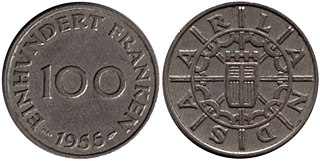
The franc is any of several units of currency. The French franc was the currency of France until the euro was adopted in 1999. The Swiss franc is a major world currency today due to the prominence of Swiss financial institutions. The name is said to derive from the Latin inscription francorum rex used on early French coins and until the 18th century, or from the French franc, meaning "frank".
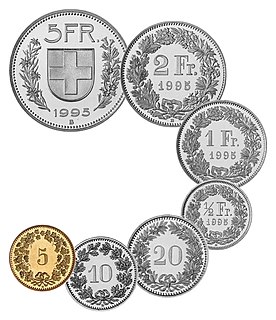
The Swiss franc is the currency and legal tender of Switzerland and Liechtenstein. It is also legal tender in the Italian exclave of Campione d'Italia. The Swiss National Bank (SNB) issues banknotes and the federal mint Swissmint issues coins.
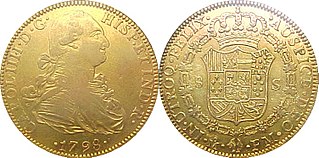
The doubloon was a two-escudo gold coin worth approximately $4 or 32 reales, and weighing 6.766 grams of 22-karat gold . Doubloons were minted in Spain and the viceroyalties of New Spain, Peru, and Nueva Granada. As the Spanish escudo succeeded the heavier gold excelente as the standard Spanish gold coin, the doubloon therefore succeeded the doble excelente or double-ducat denomination.

The Swiss franc has been the currency of Liechtenstein since 1920. The Swiss franc is legal tender since Liechtenstein is in a customs and monetary union with Switzerland. The 1980 treaty between Switzerland and Liechtenstein allows Liechtenstein to mint limited amounts of Swiss francs with a Liechtenstein inscription, but only in the form of commemorative coins, and they are not allowed to issue banknotes.
The Frank was the currency of the Swiss canton of Appenzell Ausserrhoden between 1798 and 1850. It was subdivided into 10 Batzen, each of 4 Kreuzer or 16 Pfenning. It was worth 1⁄4th the French silver écu or 6.67 g fine silver.

The Basel Thaler was a currency denomination worth 3 livres or 30 batzen used by the Swiss Canton of Basel until 1798. It was used by both the Canton and the Bishopric of Basel.
The Basel frank was the currency of the Swiss canton of Basel between 1798 and 1850. It was worth 1⁄4th the French silver écu or 6.67 g fine silver.

The Berne Thaler was a coin equivalent to the French silver écu issued by the Swiss canton of Bern. It contained 26.67 g fine silver and was valued at 4 livres.
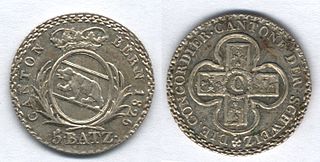
The Frank was the currency of the Swiss canton of Berne between 1798 and 1850. It was subdivided into 10 Batzen, each of 10 Rappen. It was worth 1⁄4th the French silver écu or 6.67 g fine silver.
The Fribourg Gulden was a currency denomination worth 14 Batzen of the Swiss canton of Fribourg until 1798.
The Frank was the currency of the Swiss canton of Fribourg between 1798 and 1850. It was subdivided into 10 Batzen, each of 4 Kreuzer or 10 Rappen. It was worth 1⁄4th the French silver écu or 6.67 g fine silver.

The Frank was the currency of the Swiss canton of Luzern between 1798 and 1850. It was subdivided into 10 Batzen, each of 10 Rappen or 20 Angster. It was worth 1⁄4th the French silver écu or 6.67 g fine silver.
The gulden was the currency of the Swiss canton of Luzern until 1798. It was subdivided into 40 schilling, each of 3 rappen or 6 angster. Coins were also issued denominated in kreuzer and batzen. The French silver écu was equivalent to 3 gulden.
The Gulden was the currency of the Swiss canton of Schwyz until 1798. It was subdivided into 40 Schilling, each of 3 Rappen or 6 Angster. Coins were also issued denominated in Groschen. The French silver écu was equivalent to 21⁄2 Gulden.
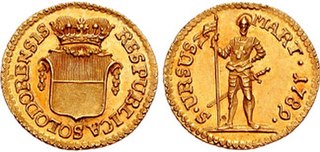
The Solothurn Thaler was a coin equivalent to the French silver écu issued by the Swiss canton of Solothurn until 1798. It contained 26.67 g fine silver and was valued at 4 livres.
The Frank was the currency of the Swiss canton of Solothurn between 1798 and 1850. It was subdivided into 10 Batzen, each of 4 Kreuzer or 10 Rappen. It was worth 1⁄4th the French silver écu or 6.67 g fine silver.
The Valais thaler was a coin equivalent to the French silver écu issued by the Swiss canton of Valais until 1798. It contained 26.67 g fine silver and was valued at 4 livres.
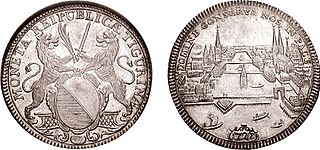
The cantons of the Old Swiss Confederacy used a currency system consisting of based on the old unit of the Schilling, with the Schilling divided into 4 Rappen or 12 Haller. The Taler was a large silver coin equivalent to 72 Schilling or 2 Gulden that came into use in the 16th century. The Batzen was an intermediate coin equivalent to 2 Schilling or 1⁄18Gulden.

The coins of the Swiss franc are the official coins used in Switzerland and Liechtenstein. The name of the subunit is centime in French and internationally, Rappen in German, centesimo in Italian, and rap in Romansh. There are coins in denominations of 5 centimes, 10 centimes, 20 centimes, ½ franc, 1 franc, 2 francs and 5 francs.
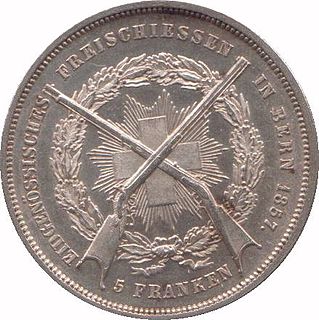
A shooting thaler is a silver coin in thaler size minted to commemorate a Schützenfest or free shooting in Switzerland.
References
- ↑ "Dictionary of the Coins of the World [D]". Treasure Realm. Retrieved 7 September 2019.
- 1 2 "Gold Duplone". Coin and Bullion Pages. Retrieved 7 September 2019.
- ↑ "16 Franken (Duplone) 1800". Schoeller Münzen Edelmetalle. Retrieved 7 September 2019.
- ↑ "Coins of the Helvetic Republic" (PDF). Money Museum. p. 2. Retrieved 7 September 2019.
- ↑ Jan Gyllenbok (2018). Encyclopaedia of Historical Metrology, Weights, and Measures, Volume 3. Birkhäuser. p. 271. ISBN 9783319667126 . Retrieved 7 September 2019.
- ↑ "Information on Coin Specifications". American Gold Investing. Archived from the original on 10 April 2010. Retrieved 7 September 2019.